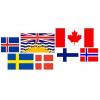News: Roald Amundsen’s message to us - 100 years later

Roald Amundsen’s message to us - 100 years later
- By Jason Robinson and Phoenix Le
Last week I had the pleasure of attending the opening of an exhibit at the Vancouver Maritime Museum. The exhibit features a collection of pictures that were taken over 100 years ago by Norwegian explorer Roald Amundsen. In addition to commemorating the 100thAnniversary of Amundsen’s journey to the South Pole, the exhibit chronicles in detail many aspects of Inuit culture and how this close connection with the Netsilik and Ogluli people influenced Amundsen’s thinking and ultimately may have been the very key to his success in conquering the South Pole.
Roald Amundsen was born in 1872 near Oslo Norway leaving his mark on the Heroic Era as one of the most successful polar explorers in history. He is credited as being the first person to successfully navigate the once fabled Northwest Passage and the first person to reach the South Pole. Although not the first person to reach the North Pole he is also known as the first person to be on both the North and South Poles.
Where did Amundsen acquire his amazing drive and passion for Arctic adventure and exploration? We know that as a teenager Amundsen was captivated by the works of Sir John Franklin, the great British explorer. Franklin’s stories of bravery and sufferings in his Arctic explorations “thrilled” young Amundsen. Amundsen later wrote in his autobiography that he had read Franklin’s stories with a “fervid fascination which has shaped the whole course of my life” and that he (Amundsen) “secretly… irretrievably decided to be an Arctic explorer.” It was with this fixation that, after the death of his mother, Amundsen left his medical studies at the age of 21 to begin his career of adventure.
During the early 20th century, gone was the ideal where you took your world with you and set about defeating a place such as Sir Franklin had done. Instead a new and young breed of Arctic explorers approached their expeditions as would modern mountaineers. This meant having a small group of experts along with a selection of specialized skills honed to perfection. It also meant that in dynamic arctic terrains that were constantly changing, one had to stay both physically and mentally flexible.
Inspired by this new approach, Amundsen took to learning at the feet of a group of experts that the British Navy never thought to consult, the working seamen. These men, who for centuries had navigated the ice at the edge of the Arctic, had the requisite skill set and were happy to share their knowledge. Amundsen started working on the ships as a mate on the Belgica Expedition to Antarctica, learning much from this two year excursion from 1897-1898. It was not until the summer of 1903 that he finally set sail in his own ship the Gjøa. On this second hand fishing boat he set out to follow in the footsteps of his childhood hero, Sir John Franklin to find a route through the Northwest Passage.
Amundsen spent 1903-1905 in the area that is now referred to as Gjoa Haven, on King William Island in the Nunavut Territory. Through extensive interaction with the local Inuit peoples, Amundsen and his men acquired the knowledge and skills crucial to survival in the harsh Arctic conditions. Amundsen learned to dog sled, hunt for seals, kayak, fish, and even wear the clothes of the Inuit. These skills he learned from a people who lived at one with the land. The Inuit lived in a deep relationship with the land, not dominating it but living as a part of the ecosystem. It was his study and understanding of this relationship, and the resulting skills he acquired that were most certainly keys to the success of his team in becoming the first to finally circumnavigate the Northwest Passage in 1906.
Building on his experience working on expeditions in polar regions, and the skills that he learned from the Inuit communities during his voyage through the Northwest Passage, Amundsen set his sights on the conquering the South Pole. Amundsen and his crew left Oslo in Fridtjof Nansen’s old ship the Fram on the 3rd of June 1910. After reaching the Bay of Whales, Antarctica and setting up base camp, on October 19th 1911, Amundsen with his four men and their skis, sleds and 52 dogs departed for the South Pole. The team arrived after 56 arduous days to become the first to reach the South Pole on December 14, 1911.
Roaming the Vancouver Maritime Museum exhibit and viewing Amundsen’s photographs of his experiences with the Inuit and their culture, one cannot help but appreciate the parallelism between the history of this man’s exploration to some of the predicaments faced by our society today.
Amundsen was not the only person who sought to be the first to the South Pole. What set him apart? His success when contrasted with that of other polar explorers clearly seems to hinge on his willingness to learn. His advantage was born from a desire to seek out knowledge from others, looking to nature for guidance as well as to indigenous systems (such as dog sleds, and skis) which were proven to be ideally suited to their environment. This wisdom served him where others had disregarded it.
There is much that can be learned from Amundsen for today’s modern society, but will we be brave enough to not simply disregard it? In our seemingly insatiable desire to consume there is an arrogance and ignorance that overlooks more sustainable, harmonious and symbiotic systems. 100 years after Amundsen’s last journey, there is perhaps a sort of time encapsulated message to listen and learn from others as Ronald Amundsen did; to the people that have been here before us – our parents, our grandparents, and aboriginal peoples, and to learn from our traditions, our heritage, and our inextricable connection to the land.
To succeed in addressing the myriad problems that we are faced with today, we would do well to challenge our current ways of thinking and be open to approaching the issues from new and different angles. For me, that first step is to listen.
------------------------------------------------------------------------------------------------
The exhibition “Cold Recall – Roald Amundsen’s reflections from the Northwest Passage” is being held in the Teekay Gallery, in the Vancouver Maritime Museum in cooperation with the Fram Museum in Oslo. The exhibit runs from March 18, 2011 to September 16, 2011 and has a number of prominent speakers including:
March 18, 2011: Morten Hoglund, Chair of the Standing Committee of Parliamentarians of the
Arctic region: Common challenges in the north.
March 26, 2011: Captain Russell D. Roberts: Experiences of a recent passage through the Northwest passage.
April 16, 2011: Doreen Riedel, daughter of polar explorer Henry Larsen: Roald Amundsen’s influence on her father Henry Larsen.
May 28, 2011: Else Berit Eikeland, Norwegian Ambassador to Canada: The Norwegian northern strategy.
Photo: The Fram Museum, Olso, Norway
Category:

































